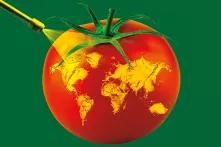
Even though the EU’s pesticide legislation is the most sophisticated, it has failed to achieve a reduction in use. The EU’s Farm to Fork Strategy seeks to change that. Many questions remain.

Pesticides are high on the agenda at the European level. In its Farm to Fork Strategy from May 2020, the European Commission committed to the objective of reducing the use and risks of synthetic pesticides by 50 percent until 2030, the use of the most hazardous substances by 50 percent, and to introduce a new regulation to reach that goal. The “Save Bees and Farmers” European Citizens’ Initiative, which gathered over 1.2 million signatures, demands an even higher reduction of 80 percent by 2030, a complete phase-out by 2035, and strong support to be given to farmers in their transition towards agroecology.
The current policy to bring down pesticide use, the “Sustainable Use of Pesticides Directive”, was introduced in 2009. The legislation aimed to limit the use of pesticides by promoting alternative practices like Integrated Pest Management (IPM). IPM principles give priority to preventative measures and biocontrol. Biopesticides and as a last step synthetic pesticide are only an option, when all other measures have failed.
However, more than a decade after the adoption of the directive, the EU Court of Auditors (ECA), the Union’s external auditor to assess among other things the effectiveness of EU action, found that only limited progress has been achieved in measuring and reducing the use and risk of pesticides in the EU. Over the period 2011 to 2018, the sales of pesticides remained stable at around 360 thousand tonnes per year in the EU. The ECA outlined several flaws in the EU framework. For example, there is the missing alignment between the Common Agricultural Policy (CAP) and reduction policy. The CAP determining the funding and priorities of EU agriculture. Another key issue is the lack of appropriate indicators on European level to measure the potential decrease in pesticides. Indicators are mainly based on sales data of pesticides and therefore do not take into account the agriculture area, the volume or the way these substances are used.
From the EU budget, farmers receive financial support based, for the most part, on the number of hectares of the farm. Currently, the EU does not tie the receipt of this EU funding to the respect of IPM principles and other rules laid out in the pesticide directive. This is unlikely to change substantially with the latest attempt to reform the CAP, entering into force in 2023.
Finally, the way Member States handled the implementation of the EU framework into national rules, is another reason for its limited success. Several Member States delayed the transposition into national law and were slow to develop national action plans to implement concrete measures. Civil society organizations furthermore criticised Member States for not using the legroom they have within the CAP to make the use of IPM more attractive. Member States can use funding from the CAP to offer voluntary schemes that incentivize techniques which lead to a lower use of synthetic pesticides. However, these schemes fail to take a systematic approach needed to reduce pesticides.
According to a joint statement of over 70 civil society organizations, the new EU legislation needs to address all of these concerns to be effective in transforming the food and agriculture system to protect citizens’ health, biodiversity and the climate. They also demand that the regulation entails ambitious and legally binding reduction targets at both EU and national levels, a complete phase-out of the most hazardous pesticides and the use of damaging practices, like aerial spraying or seed coating, as well as a strengthened definition of IPM. Such practices are part of the transformation towards agroecology.
There are also discussions about the role of the EU when it comes to the use of pesticides in other countries. In its Chemicals Strategy for Sustainability from October 2020, the European Commission commits to put an end to pesticides banned in the EU being exported by EU companies to other parts of the world. But this has yet to be translated into actual policies.
The timeline for the reform on the pesticide directive was originally expected at the beginning of 2022 – but was delayed to summer 2022 due to Russia’s war of aggression against Ukraine. The co-decision between the European Parliament and the Council are expected to go well into 2023 with the new rules likely only being made applicable starting 2024.

